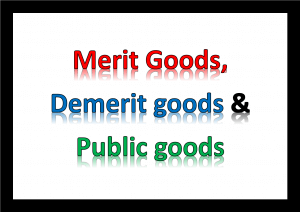Merit goods are the goods that are provided generally by the government to certain sections of the society. Unlike in the case of pure public goods, the merit goods are not provided to the entire society; rather they are given to certain targeted people. The government here believe that the deserving people may under-consume such goods and hence provides these to them at low cost or no cost.
Merit goods and Social goods
The concept of merit goods in economics was introduced by an American economist Richard A. Musgrave. Musgrave was a leading public finance specialist. He divided public goods or wants into social goods (wants) and merit goods (wants).
Social goods: are goods with non-exclusion principle and their supply is jointly made.
Merit goods: are those public goods which results in interference with consumer choices. Here the government will be providing the goods (merit) to specific section of the society because of their backward status, poverty etc (depending on their merit).
An example for merit goods or wants is the government’s expenditure in the educational sector (like the Sarva Shiksha Abhiyan) for the schooling of the poor. The comparison between the social wants and merit wants is simple. In the case of social wants, the goods are provided to all sections of the society (road, defense). In the case of merit wants, the good is provided to certain target groups.
Poor people may under-consume most of the merit goods because of their inability to pay. To counter this under consumption, the government either subsidises them or makes them completely free. In this way, consumption does not depend on the ability to pay of the consumer.
Features of Merit Goods;
- Merit goods are not provided on the basis of consumer’s preference. Rather, they are given by the government on its own preferences.
- Merit goods are given by the government for a particular section of the society. But ion the case of public goods, they are provided to all sections of the society.
- Merit goods produces social benefit by directly benefiting the sections that receive those goods. When primary education is provided to poor sections, it benefits the nation.
- Merit goods produces positive externalities. This means that as a result of merit goods supply, the receivers give backs some related benefits to the society.
- Merit goods are aimed for personal consumption and not for the consumption of all.
Examples for merit goods
Merit goods include primary education, basic health care, life insurance to poor people etc. The report by the National Institute of Public Finance and Policy titled “Central Government Subsidies in India” (2004), classifies merit goods under two categories- Merit I and Merit II, in terms of their priority.
Merit I – Elementary education, primary healthcare, prevention and control of diseases, social welfare and nutrition, soil and water conservation, ecology, and environment.
Merit II – Education (other than elementary), sports and youth services, family welfare, urban development, forestry, agricultural research and education, other agricultural programmes, special programmes for rural development, land reforms, other rural development programmes, special programmes for north-eastern areas, flood control and drainage, non-convention energy, village and small industries, ports and light houses, roads and bridges, inland water transport, atomic energy research, space research, oceanographic research, other scientific research, census surveys and statistics, and meteorology.
Non-Merit – All others.
Non-merit goods and demerit goods
Non-merit goods and demerit goods are used interchangeably. But the items that are not merit goods can be considered as non-merit goods. Whereas those that are extremely opposed to merit goods can be considered as demerit goods.
In the case of non-merit goods, there is no tendency to under consumption; rather there is a tendency for overconsumption. Similarly, the consumption depends upon the individual’s ability to pay or his income. High income encourages him to consume the good in more quantities.
What are demerit goods?
A demerit good is a good whose consumption leaves a negative impact on its consumer and on others in the society. An example for demerit good is alcohol. Consumption of alcohol can cause health problems for the drinker. Besides this personal cost, it also leads to external costs as the taxpayer may have to pay for the drunkard consumer’s healthcare as a result. If it is overconsumed the marginal social costs exceed marginal private(drunkard’s) costs, due to the external costs imposed on society. Hence a high tax should be imposed on de-merit goods.
Difference between merit goods and public goods
Public goods are provided to the entire society. Merit goods are provided to targeted individuals. Hence in the case of merit goods, there is exclusion. On the other goods, there is no exclusion under public goods.
What are public goods?
Public goods refer to those goods which satisfy public wants. The main attribute of public good is that they are supplied by the government jointly for the entire public.
Main features of public goods are non-exclusion, nonrivalry and indivisibility.
Principle of non-exclusion: in the case of public goods, they ate collectively supplied to all sections of the community.
Principle of Indivisibility: in the case of public goods, they are indivisible i.e., they cannot be divided to confine the supply to a selected people.
Non-rivalry: consumption of public goods is non-rival. This means that the use of public goods some people doesn’t reduce its availability to others.
Examples for public goods are defense services, pollution control, streetlight etc.
*********









